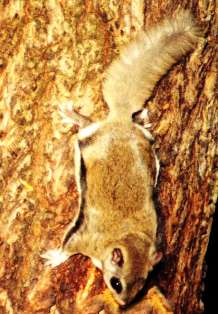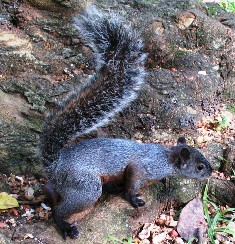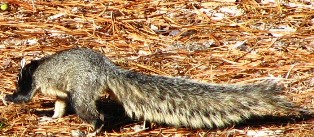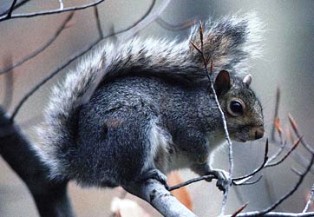Discover Florida Nature
It's time to explore the natural Florida


|
|
|
|
|
Squirrels are everywhere in Florida, from the coastal area to the
inland. These incredibly agile, cute, and wacky characters are endearing
to many, with the exception of bird lovers, since a squirrel can empty
out a bird feeder in a matter of minutes! Incredible climbers and
jumpers, Squirrels can hang from any angle it seems.  Southern
Flying Squirrel-
The southern flying squirrel is found in wooded areas through out
Florida, except the Keys. It is buff brown to gray with a white
underside, large eyes, and a broad, flat 3.5-5" tail. It is 8-10" long.
It has a loose fold of skin along each side from wrist to ankle. When it
extends its feet, this fold creates a wing-like surface so that the
squirrel can glide from tree to tree. The average glide is 30-50 feet.
The flying squirrels are the only nocturnal tree squirrels. Although it
is active in all seasons, the Southern Flying Squirrel may remain in its
nest in very cold weather and will enter torpor in times of extreme cold
or food scarcity. The most carnivorous of the tree squirrels, the
Southern Flying Squirrel feeds on nuts, acorns, seeds, berries, fungi,
lichens, birds and their nestlings and eggs, some insects, and sometimes
other vertebrates, including carrion. Hard parts and wings of larger
insects are often discarded. Flying squirrels will gnaw bark from maple
trees and drink the sap, and also eat moths that come to the sap to
feed. Great quantities of nuts, acorns, and seeds are stored for winter
use, in tree hollows, in their nests, in crotches or cracks in trees,
and in the ground. Hickory nuts and acorns may be buried throughout the
home range, adding to the general store of nuts buried by other species
of squirrels. Southern Flying Squirrels may store up to 15,000 nuts in a
season. Southern
Flying Squirrel-
The southern flying squirrel is found in wooded areas through out
Florida, except the Keys. It is buff brown to gray with a white
underside, large eyes, and a broad, flat 3.5-5" tail. It is 8-10" long.
It has a loose fold of skin along each side from wrist to ankle. When it
extends its feet, this fold creates a wing-like surface so that the
squirrel can glide from tree to tree. The average glide is 30-50 feet.
The flying squirrels are the only nocturnal tree squirrels. Although it
is active in all seasons, the Southern Flying Squirrel may remain in its
nest in very cold weather and will enter torpor in times of extreme cold
or food scarcity. The most carnivorous of the tree squirrels, the
Southern Flying Squirrel feeds on nuts, acorns, seeds, berries, fungi,
lichens, birds and their nestlings and eggs, some insects, and sometimes
other vertebrates, including carrion. Hard parts and wings of larger
insects are often discarded. Flying squirrels will gnaw bark from maple
trees and drink the sap, and also eat moths that come to the sap to
feed. Great quantities of nuts, acorns, and seeds are stored for winter
use, in tree hollows, in their nests, in crotches or cracks in trees,
and in the ground. Hickory nuts and acorns may be buried throughout the
home range, adding to the general store of nuts buried by other species
of squirrels. Southern Flying Squirrels may store up to 15,000 nuts in a
season. Mexican
Gray Squirrel-
The Mexican gray squirrel is found in wooded areas
on Elliot Key in Dade County where it was introduced from Mexico in
1938. It is gray frosted with white or all black. Its underside and
sides up to its shoulders are mahogany red. It is 16.5-22" long with an
8-12", large, bushy tail. The primary food source of the Mexican Gray
Squirrel is fruit, especially papaya, coconut, and sargent’s palms. It
will, however, browse on other plants and nuts when fruit is not
available. Mexican gray squirrels are most active in the morning,
foraging for food, and are found most often in the tops of trees, moving
easily on the branches. They often inhabit tropical or deciduous
forests. The Mexican gray squirrel often has a favorite tree that they
will use for these dens but will also have dens in less favored trees so
that they can escape from predators. Mexican
Gray Squirrel-
The Mexican gray squirrel is found in wooded areas
on Elliot Key in Dade County where it was introduced from Mexico in
1938. It is gray frosted with white or all black. Its underside and
sides up to its shoulders are mahogany red. It is 16.5-22" long with an
8-12", large, bushy tail. The primary food source of the Mexican Gray
Squirrel is fruit, especially papaya, coconut, and sargent’s palms. It
will, however, browse on other plants and nuts when fruit is not
available. Mexican gray squirrels are most active in the morning,
foraging for food, and are found most often in the tops of trees, moving
easily on the branches. They often inhabit tropical or deciduous
forests. The Mexican gray squirrel often has a favorite tree that they
will use for these dens but will also have dens in less favored trees so
that they can escape from predators.  Fox
Squirrel-The fox squirrel is found in pinelands through out
Florida, except for the Keys and perhaps Dade and Broward Counties. The
fox squirrel – named for its striking fox-like tail - is the largest
squirrel in the western hemisphere. Weighing in at about 1 kg, it is
about twice the size of a gray squirrel. Fox squirrels are highly
variable in color, and their coats can be anywhere from creamy tan to
all black. Fox squirrels prefer open park-like habitats with scattered
mature pine trees and an open understory. In some parts of southwest
Florida fox squirrels are quite abundant on golf courses that have
retained patches of open pine-oak forest. Fox squirrels use tree
cavities for sleeping quarters and birth dens, but they also construct
large leaf nests and stick nests in some areas. They are solitary,
except during the breeding season, during which time mating chases
sometimes occur. Females conceive in November and 2-3 young are born in
January. The young remain in the nest for about 75 days, and are weaned
at 90 days. Fox squirrels are strictly diurnal, and usually do not begin
foraging until mid-morning. Long leaf pine seeds and
turkey oak and live oak acorns are among their favorite foods and
they also eat fungi, buds, bulbs and insects. From May to October these
squirrels cut green longleaf pine
cones and strip off the bracts to get at the seeds. You can tell where a
fox squirrel has been feeding because of the large piles of cone pieces
on the ground. Fox
Squirrel-The fox squirrel is found in pinelands through out
Florida, except for the Keys and perhaps Dade and Broward Counties. The
fox squirrel – named for its striking fox-like tail - is the largest
squirrel in the western hemisphere. Weighing in at about 1 kg, it is
about twice the size of a gray squirrel. Fox squirrels are highly
variable in color, and their coats can be anywhere from creamy tan to
all black. Fox squirrels prefer open park-like habitats with scattered
mature pine trees and an open understory. In some parts of southwest
Florida fox squirrels are quite abundant on golf courses that have
retained patches of open pine-oak forest. Fox squirrels use tree
cavities for sleeping quarters and birth dens, but they also construct
large leaf nests and stick nests in some areas. They are solitary,
except during the breeding season, during which time mating chases
sometimes occur. Females conceive in November and 2-3 young are born in
January. The young remain in the nest for about 75 days, and are weaned
at 90 days. Fox squirrels are strictly diurnal, and usually do not begin
foraging until mid-morning. Long leaf pine seeds and
turkey oak and live oak acorns are among their favorite foods and
they also eat fungi, buds, bulbs and insects. From May to October these
squirrels cut green longleaf pine
cones and strip off the bracts to get at the seeds. You can tell where a
fox squirrel has been feeding because of the large piles of cone pieces
on the ground. Eastern
Gray Squirrel-
The eastern gray squirrel is found in wooded, suburban, and urban areas
everywhere in Florida. Basically, they live anywhere there are large,
deciduous trees (trees whose leaves die in the Fall). It is usually
light to dark grayish brown with a white or buff underside but may also
be all white or blonde with a white underside. It has small, rounded
ears. Its long tail is flattened and bushy. The tips of the hairs on
eastern gray squirrel's tail are white or gray and it is 16-20" long.
Eastern gray squirrels breeds in late winter or early spring and again
in late spring or summer. The gestation period is about 45 days and
litters contain 2-6 young. When the summer litter is due, the female
selects a new nest site, leaving the den to the juveniles. These
squirrels live in trees year-round, either in cavities or nests they
build out of leaves. Cavities are often old woodpecker holes. Nests are
usually high up in tree crotches. Nests are hard to see in the Summer,
because they are made with green leaves, and are hidden by foliage
(leaves on the trees). They are easy to see in the Winter, when the nest
leaves have turned brown and tree leaves fall to the ground. The eastern
gray squirrel chatters when disturbed. Eastern
Gray Squirrel-
The eastern gray squirrel is found in wooded, suburban, and urban areas
everywhere in Florida. Basically, they live anywhere there are large,
deciduous trees (trees whose leaves die in the Fall). It is usually
light to dark grayish brown with a white or buff underside but may also
be all white or blonde with a white underside. It has small, rounded
ears. Its long tail is flattened and bushy. The tips of the hairs on
eastern gray squirrel's tail are white or gray and it is 16-20" long.
Eastern gray squirrels breeds in late winter or early spring and again
in late spring or summer. The gestation period is about 45 days and
litters contain 2-6 young. When the summer litter is due, the female
selects a new nest site, leaving the den to the juveniles. These
squirrels live in trees year-round, either in cavities or nests they
build out of leaves. Cavities are often old woodpecker holes. Nests are
usually high up in tree crotches. Nests are hard to see in the Summer,
because they are made with green leaves, and are hidden by foliage
(leaves on the trees). They are easy to see in the Winter, when the nest
leaves have turned brown and tree leaves fall to the ground. The eastern
gray squirrel chatters when disturbed. |
|
|
Advertise | Privacy Statement | Dog Encyclopedia | Video |Contact | Alaska Nature |
|